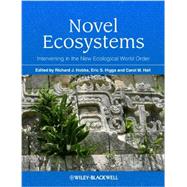
Richard J. Hobbs is Professor of Restoration Ecology and Australian Laureate Fellow at the University of Western Australia, where he leads the Ecosystem Restoration and Intervention Ecology Research Group. His current research focuses on pulling together different disciplines including restoration ecology, conservation biology and landscape ecology to develop a more effective ecology for the 21st century.
Eric S. Higgs is Professor of Environmental Studies at the University of Victoria (Canada), and director of the Mountain Legacy research project. Author of Nature by Design: People, Natural Process and Ecological Restoration, he focuses on advancing principles and practice of ecological restoration in a rapidly changing world.
Carol Hall has worked on community conservation issues in North America and Africa during the past 15 years. She is a co-author of the World Commission on Protected Areas’ Ecological Restoration for Protected Areas: Principles, guidelines and best practices (in press, Gland, Switzerland: IUCN), and currently Program Director for the Restoration Institute, University of Victoria.
Contributors
Acknowledgements
Part I: Introduction.
1. Introduction: why novel ecosystems?
Hobbs, Higgs & Hall
Part II: What are novel ecosystems?
2. Case Study: Hole-in the-Donut, Everglades Ewel
3. Towards a conceptual framework for novel ecosystems
Hallett, Standish, Hulvey, Gardener, Suding, Starzomski, Murphy, Harris
4. Islands: Where novelty is the norm
Ewel, Mascaro, Kueffer, Lugo, Lach, Gardener
5. Origins of the novel ecosystems concept
Mascaro, Harris, Lach, Thompson, Perring, Richardson, Ellis
6. Call out: Defining novel ecosystems
Part III: What we know (and don’t know) about novel ecosystems
7. Perspective: Ecological novelty isn’t new
Jackson
8. The extent of novel ecosystems: long in time and broad in space
Perring, Ellis
9. Case study: Geographic distribution and level of novelty of Puerto Rican forests
Martinuzzi, Lugo, Brandeis, Helmer
10. Novel ecosystems and climate change
Starzomski
11. Plants invasions as builders and shapers of novel ecosystems.
Richardson, Gaertner
12. Infectious disease and novel ecosystems; the novel caribbean coral reef
Yakob, Mumby
13. Case study: Do feedbacks from the soil biota secure novelty in ecosystems?
Harris
14. Fauna and novel ecosystems
Kennedy, Lach, Lugo, Hobbs
15. Case study: Ecosystem transformations along the Colorado Front Range: Prairie dog interactions with multiple components of global environmental change
Seastedt, Hartley, Nippert
16. Perspective: Plus ça change, plus c'est la même chose
Murphy
Part IV: When and how to intervene
17. Perspective: From rivets to rivers
Mascaro
18. Incorporating novel ecosystems into management frameworks
Hulvey, Standish, Hallett, Starzomski, Murphy, Nelson, Gardener, Kennedy, Seastedt, Suding
19. Case Study: The management framework in practice: Making decisions in Atlantic Canadian Meadows. Chasing the Elusive Reference State.
Murphy
20. Case Study: The management framework in practice: Prairie dogs at the urban interface: Conservation solutions when ecosystem change drivers are beyond the scope of management actions
Seastedt
21. Case Study: The management framework in practice: How social barriers contribute to novel ecosystem maintenance: Managing Reindeer Populations on St. George Island, Pribilof Islands, Alaska Hulvey
22. Case Study: The management framework in practice: Can’t see the wood for the trees: the changing management of the novel Miconia-Cinchona ecosystem in the humid highlands of Santa Cruz Island, Galapagos
Gardener
23. Case Study: The management framework in practice: Using the Decision Framework for Designer Wetlands as Novel Ecosystems.
Murphy
24. Characterizing novel ecosystems: challenges for measurement
Harris, Murphy, Nelson, Perring, Tognetti
25. Case Study: Novelty measurement in Pampean grasslands
Tognetti
26. Plant materials for novel ecosystems
Jones
27. Case study: Management of novel ecosystems in the Seychelles
Kueffer, Beaver, Mougal
28. Perspective: Moving to the dark side
Kennedy
Part V: How do we appreciate novel ecosystems?
29. Perspective: Coming of age in a trash forest
Marris
30. Engaging the public in novel ecosystems
Yung, Schwarze, Carr, Chapin, Marris
31. Valuing novel ecosystems
Light, Thompson, Higgs
32. Case study: A rocky novel ecosystem: industrial origins to conservation concern
Perring
33. The policy context: building laws and rules that embrace novelty
Bridgewater, Yung
34. Perspective: Lake Burley Griffin
Bridgewater
35. Case study: Shale “bings” in Central Scotland: from ugly blots on the landscape to cultural and biological heritage
Harvie, Hobbs
Part VI: What’s Next?
36. Perspective: A Tale of Two Natures
Higgs
37. Concerns about novel ecosystems
Standish, Thompson, Higgs, Murphy
38. Novel urban ecosystems and ecosystem services
Perring, Manning, Hobbs, Lugo, Ramalho, Standish
39. Ecosystem stewardship as a framework for conservation in a directionally changing world
Seastedt, Suding, Chapin
40. Case study: Novel social-ecological systems in the north: potential pathways towards ecological and societal resilience
Chapin, Robards, Johnstone, Lantz, Kokelj
41. Perspective: Is everything a novel ecosystem? If so, do we need the concept?
Marris, Mascaro, Ellis
Part VII: Synthesis and conclusions
42. What do we know about, and what do we do about, novel ecosystems?
Hobbs, Higgs, Hall
Index
The New copy of this book will include any supplemental materials advertised. Please check the title of the book to determine if it should include any access cards, study guides, lab manuals, CDs, etc.
The Used, Rental and eBook copies of this book are not guaranteed to include any supplemental materials. Typically, only the book itself is included. This is true even if the title states it includes any access cards, study guides, lab manuals, CDs, etc.